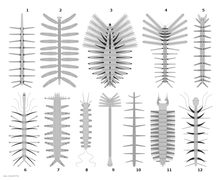
Back فصيات الأقدام Arabic Lobopodlar Azerbaijani Lobòpodes Catalan Lobopoden German Lobopodia English Lobopodia Esperanto Lobopodia Spanish پهنپاتباران Persian Lobopodia Finnish Lobopodia French
| Lobopodia Rentang fosil: Kambrium Seri 2–Pennsylvanium Awal[1] Takson keturunan Onychophora, Tardigrada, dan Euarthropoda bertahan hingga masa kini, kemungkinan fosil jejak dari Ediakara.[2] |
|---|
 Rekonstruksi dari beragam lobopodia. 1: Microdictyon sinicum, 2: Diania cactiformis, 3: Collinsovermis monstruosus, 4: Luolishania longicruris, 5: Onychodictyon ferox, 6: Hallucigenia sparsa, 7: Aysheaia pedunculata, 8: Antennacanthopodia gracilis, 9: Facivermis yunnanicus, 10: Paucipodia inermis, 11: Jianshanopodia decora, 12: Hallucigenia fortis
|
| Klasifikasi ilmiah |
|
|
| Kelompok yang termasuk |
|
| Kelompok yang tidak termasuk |
|
Kelompok mahkota Euarthropoda |
| Sinonim |
|
Lobopodian adalah anggota dari kelompok informal Lobopodia[3] (dari kata Yunani, berarti "kaki tumpul"), atau filum yang didirikan secara formal Lobopoda (Cavalier-Smith, 1998).[4] Kelompok tersebut merupakan anggota panarthropoda yang memiliki kaki tumpul yang disebut dengan lobopod,[5] sebuah istilah yang terkadang juga digunakan untuk merujuk nama kelompok ini.[6][7] Meski definisi pasti dari Lobopodia berbeda-beda tergantung literatur,[8] umumnya istilah ini merujuk kepada sekelompok panarthropoda punah bertubuh halus berbentuk cacing dengan kaki tumpul, dengan anggota yang paling umum dikenal yaitu Aysheaia dan Hallucigenia.[9][10][5]

Fosil lobopodia hampir lengkap yang paling tua berasal dari periode Kambrium Awal; beberapa juga diketahui dari Lagerstratte Ordovisium, Silur dam Karbon.[12][13][14] Beberapa memiliki cakar yang keras, duri atau plat, yang umumnya terawtkan sebagai mikrofosil termineralisasi atau karbonat dari stratum Kambrium.[15][16] Pengelompokan dari Lobopodia dianggap sebagai sebuah kelompok parafiletik, karena ketiga anggota panarthropoda yang masih hidup (Artropoda, Tardigrada dan Onychophora) diperkirakan berevolusi dari leluhur lobopodia.
- ^ Haug, J.T.; Mayer, G.; Haug, C.; Briggs, D.E.G. (2012). "A Carboniferous non-Onychophoran Lobopodian reveals long-term survival of a Cambrian morphotype". Current Biology. 22 (18): 1673–1675. doi:10.1016/j.cub.2012.06.066
 . PMID 22885062.
. PMID 22885062.
- ^ Xiao, Shuhai; Chen, Zhe; Pang, Ke; Zhou, Chuanming; Yuan, Xunlai (January 2021). "The Shibantan Lagerstätte: insights into the Proterozoic–Phanerozoic transition". Journal of the Geological Society (dalam bahasa Inggris). 178 (1). doi:10.1144/jgs2020-135. ISSN 0016-7649.
- ^ Snodgrass, R.E. (1938). "Evolution of the Annelida, Onychophora, and Arthropoda". Smithsonian Miscellaneous Collections. 97 (6): 1–159.
- ^ Cavalier-Smith, T. (1998). "A revised six-kingdom system of life". Biological Reviews (dalam bahasa Inggris). 73 (3): 203–266. doi:10.1017/S0006323198005167. PMID 9809012.
- ^ a b Ortega-Hernández, Javier (2015-10-05). "Lobopodians". Current Biology (dalam bahasa Inggris). 25 (19): R873–R875. doi:10.1016/j.cub.2015.07.028
 . ISSN 0960-9822. PMID 26439350.
. ISSN 0960-9822. PMID 26439350.
- ^ Budd, Graham; Peel, John (1998-12-01). "A new Xenusiid lobopod from the early Cambrian Sirius Passet fauna of North Greenland". Palaeontology. 41: 1201–1213.
- ^ Jianni Liu; Degan Shu; Jian Han; Zhifei Zhang; Xingliang Zhang (2006). "A large xenusiid lobopod with complex appendages from the Lower Cambrian Chengjiang Lagerstätte" (PDF). Acta Palaeontol. Pol. 51 (2): 215–222. Diarsipkan dari versi asli (PDF) tanggal 2022-10-10. Diakses tanggal 9 February 2011.
- ^ Ortega-Hernández, Javier (December 2014). "Making sense of 'lower' and 'upper' stem-group Euarthropoda, with comments on the strict use of the name Arthropoda von Siebold, 1848". Biological Reviews of the Cambridge Philosophical Society. 91 (1): 255–273. doi:10.1111/brv.12168. ISSN 1469-185X. PMID 25528950.
- ^ Liu, Jianni; Dunlop, Jason A. (2014-03-15). "Cambrian lobopodians: A review of recent progress in our understanding of their morphology and evolution". Palaeogeography, Palaeoclimatology, Palaeoecology (dalam bahasa Inggris). 398: 4–15. Bibcode:2014PPP...398....4L. doi:10.1016/j.palaeo.2013.06.008. ISSN 0031-0182.
- ^ Ou, Qiang; Mayer, Georg (2018-12-01). "A Cambrian unarmoured lobopodian, †Lenisambulatrix humboldti gen. et sp. nov., compared with new material of †Diania cactiformis". Scientific Reports. 8 (1): 13667. Bibcode:2018NatSR...813667O. doi:10.1038/s41598-018-31499-y
 . PMC 6147921
. PMC 6147921  . PMID 30237414.
. PMID 30237414.
- ^ Ortega-Hernández, Javier (December 2014). "Making sense of 'lower' and 'upper' stem-group Euarthropoda, with comments on the strict use of the name Arthropoda von Siebold, 1848". Biological Reviews of the Cambridge Philosophical Society. 91 (1): 255–273. doi:10.1111/brv.12168. ISSN 1469-185X. PMID 25528950.
- ^ van Roy, P.; Orr, P.J.; Botting, J.P.; Muir, L.A.; Vinther, J.; Lefebvre, B.; Hariri, K.E.; Briggs, D.E.G. (2010). "Ordovician faunas of Burgess Shale type". Nature. 465 (7295): 215–218. Bibcode:2010Natur.465..215V. doi:10.1038/nature09038. PMID 20463737.
- ^ von Bitter, P.H.; Purnell, M.A.; Tetreault, D.K.; Stott, C.A. (2007). "Eramosa Lagerstätte—Exceptionally preserved soft-bodied biotas with shallow-marine shelly and bioturbating organisms (Silurian, Ontario, Canada)". Geology. 35 (10): 879. Bibcode:2007Geo....35..879V. doi:10.1130/G23894A.1.
- ^ Haug, J.T.; Mayer, G.; Haug, C.; Briggs, D.E.G. (2012). "A Carboniferous non-Onychophoran Lobopodian reveals long-term survival of a Cambrian morphotype". Current Biology. 22 (18): 1673–1675. doi:10.1016/j.cub.2012.06.066
 . PMID 22885062.
. PMID 22885062.
- ^ Caron, J.-B.; Smith, M.R.; Harvey, T.H.P. (2013). "Beyond the Burgess Shale: Cambrian microfossils track the rise and fall of hallucigeniid lobopodians". Proceedings of the Royal Society B: Biological Sciences. 280 (1767): 20131613. doi:10.1098/rspb.2013.1613. PMC 3735267
 . PMID 23902914.
. PMID 23902914.
- ^ Topper, T.P.; Skovsted, C.B.; Peel, J.S.; Harper, D.A.T. (2013). "Moulting in the lobopodian Onychodictyon from the lower Cambrian of Greenland". Lethaia. 46 (4): 490–495. doi:10.1111/let.12026.